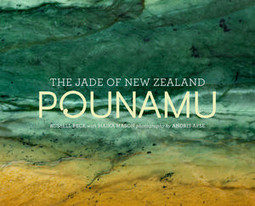Pounamu: the Jade of New Zealand
Pounamu: the jade of New Zealand
Russell Beck with Maika Mason; photography by Andris Apse.
N.Z. Penguin in association with Te Rūnanga o Ngāi Tahu, 2010.
ISBN 9780670074884
The Blurb:
"Pounamu is a celebration of jade in its many forms. It is a magnificent tribute to this New Zealand icon, the finest book on the subject ever published. Through the eyes of pounamu specialists Russell Beck and Maika Mason, we explore jade's powerful connection with the natural environment, its Maori myths and history, jewellery and taonga, geology and technical characteristics, places where pounamu is found, methods of working, cultural issues regarding the ownership and management of jade as a resource, contemporary carving, and its significance in the international arena. The text is enhanced by the exquisite, timeless landscape photography of Andris Apse, which sets pounamu firmly in the South Island mountain environment from which it emerges in its natural state."
Review
This is a POP page.
|
Beck here returns to a subject he has published on several times before, but this publication far exceeds the earlier ones in size, scope and appearance – it is a sumptuous all-colour effort.
The authors update what is known of the sources of the stone, a subject to which Beck has been a material contributor. The excitement at the re-finding of the Te Koruka source is apparent in the account, even years after the event. The material on sources is supported by wonderful photography of the places – it should almost sell as a travel book for these alone. A fascinating chapter is on the modern phenomenon of touch stones – large little-modified blocks that the public can touch in the entrances to buildings or in institutions. The cultural practices around obtaining these while primarily modern, are a legitimate restoration of past mana. There is a valuable chapter on the Pakeha lapidaries who produced so much in the way of replicas and new jewellery in the late 19th and early 20th century.
For archaeologists the chapter on Maori artefacts will hold keen interest. The story of some artefacts with known traditional histories is told nicely. Regrettably the South Island source of the stone has captured the artefacts shown as well. Few items are illustrated from northern museums. There are photographic illustrations only, without museum numbers or scales, but the splendour of the photographs represses too much quibbling about this.
The authors support the conventional belief in the change of manufacturing technology from flaking / pecking to sawing, but the continuation of flaking until late in history is not discussed though it seems to have occurred where the stone was in good supply. They note that the later form of tiki with the tilted head but do not cite Skinner’s idea that many are of this form because they were converted from adzes once iron tools supplanted the need for these.
The argument is presented that many of what have been conventionally thought of as amorphous amulets are in fact knives. This is a readily testable hypothesis- it should be apparent in use wear where items have been used this way. A less credible argument is that as adzes were shortened by too many re-sharpenings, they were sawn into narrower blocks for chisels. The example shown in this process is certainly a lot longer than many northern nephrite adzes, so the functionality argument looks suspect. And why chisels? Ear drop pendants continued to be desired after nephrite adzes and chisels were replaced by iron. They are a more likely product – shown indeed by chisels themselves being known in the process of conversion to pendants. So, the artefact chapter is stimulating rather than just visually stunning.
Shelve with the archaeology tomes or on the coffee table? Take your pick – it is worthy in either place.
